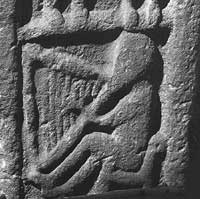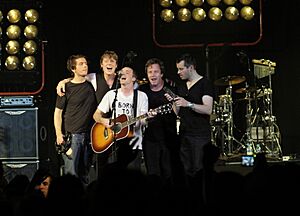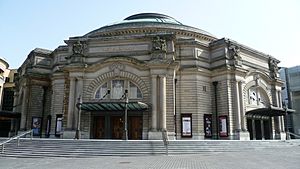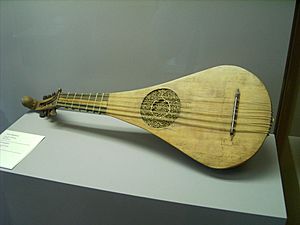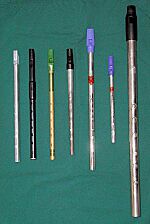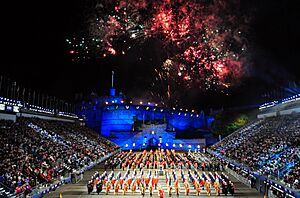Music of Scotland facts for kids
Scotland is famous worldwide for its amazing music! This includes traditional Scottish folk music, which has stayed popular for a long time. Even when pop music became big, Scottish folk music kept its special place. You'll hear different styles like ballads, reels, jigs, and airs.
The bagpipes are a super important Scottish instrument. They have been around since the 1400s and are a symbol of Scotland. Other cool instruments include the tin whistle, accordion, and fiddle.
Music in Scotland has a very long history. Over 2,300 years ago, a very old stringed instrument, like a small harp, was found on the Isle of Skye. The first printed Scottish music appeared in 1662. John Forbes from Aberdeen published the first collection of traditional Scottish songs.
Today, Scotland has many popular musicians and bands. Famous artists like Calvin Harris, Paolo Nutini, Amy Macdonald, and Lewis Capaldi are from Scotland. You might also know bands like Travis, Texas, and the Bay City Rollers.
Scotland loves to celebrate its music! There are many music festivals and award shows. The big TRNSMT festival happens every July in Glasgow Green. Other popular festivals include Celtic Connections and the Royal Edinburgh Military Tattoo. Awards like the Scottish Album of the Year Award also celebrate Scottish musical talent.
Contents
Exploring Scottish Music
Ancient Sounds and Early Melodies
Music has been a part of Scotland for a very long time! Stringed instruments were played even in the Iron Age. The oldest stringed instrument found in Europe, a lyre (like a small harp), was discovered on the Isle of Skye. It dates back over 4,300 years!
In ancient times, people called Bards were important. They were not just musicians; they were also poets, storytellers, and historians. They often played the harp and kept traditions alive through songs and stories.
During the Middle Ages, Scottish church music started to be influenced by music from other European countries. Kings like James I and James IV loved music. James I, who was a poet and composer, brought new musical styles to Scotland. James IV made the Chapel Royal at Stirling Castle a big center for church music.
King James V was also a great supporter of music. He played the lute and brought French songs and groups of instruments called viols to his court.
Later, during a time called the Scottish Reformation, there were changes in church music. Organs were removed from churches, and people focused more on singing metrical psalms (songs based on Bible verses).
However, when Mary, Queen of Scots returned from France in 1561, she brought back a love for court music. She played the lute and virginals and was a good singer. She had musicians who played lutes and viola players. Since church organs were gone, other instruments like trumpets, drums, and bagpipes were used for church services.
A famous composer from this time was Robert Carver. King James VI also loved the arts and supported music. He rebuilt the Chapel Royal. When he became King of England in 1603, the main royal support for music moved to England.
Traditional Folk Music
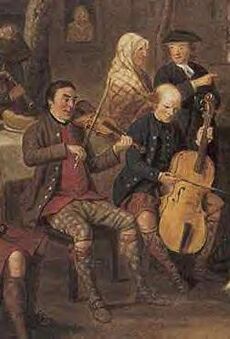
Scotland has always had a lively tradition of popular music. One of the oldest songs with a melody is the Pleugh Song. Even after the Reformation, folk music continued to thrive. This was despite efforts by the Church of Scotland to stop dancing and events like penny weddings.
This period also saw the rise of ceòl mór, or the "great music" of the bagpipe. This music often reflected its military roots with battle tunes and laments. In the 1600s, piping families like the MacCrimmonds became very skilled. The fiddle also became popular in the Highlands. Famous musicians included fiddler Pattie Birnie and piper Habbie Simpson.
Many old Scottish ballads, some from the 1200s, were passed down through generations. They were finally written down in the 1700s. The first printed collection of non-religious music appeared in the 1600s. Later, people like Allan Ramsay and Robert Burns collected many songs.
After World War II, traditional music faced challenges but stayed alive. People like Alan Lomax and Hamish Henderson helped keep it going by collecting, publishing, and recording songs. In the 1960s, folk clubs became popular. New Scottish folk artists like The Corries emerged. There was also popular Scottish music on TV, like The White Heather Club, which used traditional Scottish images.
New styles like "folk baroque" mixed American and British folk music, with guitarists like Bert Jansch. Other groups like The Incredible String Band explored "psychedelic folk." Acoustic groups like The Tannahill Weavers and Silly Wizard continued playing traditional music.
Celtic rock also developed, blending rock with traditional Celtic sounds. Bands like Runrig and Capercaillie became very successful in the 1980s. Runrig made history with "An Ubhal as Àirde (The Highest Apple)", the first song sung in Scottish Gaelic to chart in the UK.
Scottish people living in other countries, known as the Celtic Diaspora, also kept their musical traditions alive. Bands like Seven Nations from the US and Great Big Sea from Canada continue this legacy.
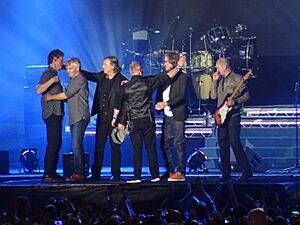
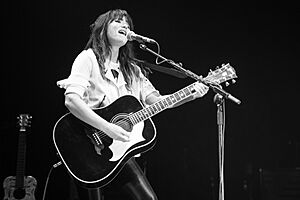
Classical Music's Journey

The development of classical music in Scotland was affected by the Scottish Reformation in the 1500s. However, concerts featuring "Scottish airs" (tunes) grew in the 1600s. Classical instruments were brought to Scotland. Music in Edinburgh thrived with support from people like Sir John Clerk of Penicuik.
The Italian style of classical music arrived in Scotland in the 1720s with cellist Lorenzo Bocchi. The Musical Society of Edinburgh was formed in 1728. Scottish composers like Thomas Erskine, 6th Earl of Kellie started creating classical music. He was the first Scot known to write a symphony.
In the mid-1700s, composers like James Oswald and William McGibbon created the "Scots drawing room style." They took Scottish tunes and made them popular for a wider audience. In the 1790s, Robert Burns worked to collect Scottish national songs. He helped adapt folk songs with classical arrangements.
Classical music saw a revival in Scotland from the mid-1800s, helped by visits from famous composers like Chopin and Mendelssohn. By the late 1800s, Scotland had its own school of orchestral and opera music. Important composers included Alexander Mackenzie and Hamish MacCunn.
After World War I, composers like Robin Orr were influenced by modern styles and Scottish melodies. The Edinburgh Festival started in 1947, leading to more classical music in Scotland. Scottish Opera was founded in 1960. Famous modern composers include James MacMillan and Helen Grime. Craig Armstrong has created music for many films.
Major Scottish orchestras include the Royal Scottish National Orchestra (RSNO) and the BBC Scottish Symphony Orchestra (BBC SSO). Important venues are Glasgow Royal Concert Hall and Usher Hall in Edinburgh.
Modern Pop and Rock Hits
Music from the 1950s to 1960s
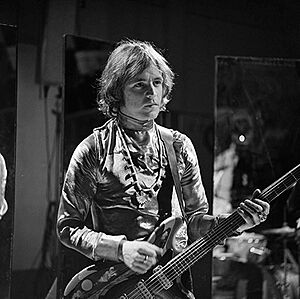
Scotland didn't have many famous rock or pop bands in the 1950s. But in the 1960s, two Scottish musicians became very important in international rock music: Donovan and Jack Bruce. Donovan's music in the 1960s helped start the British folk rock and psychedelic rock styles.
Jack Bruce co-founded the supergroup Cream in 1966. Their debut album Fresh Cream was a key moment in blues-rock history, showing off very skilled and creative playing. Bruce also contributed to important jazz-rock music.
An Edinburgh band called 1-2-3 (later Clouds) was seen as an early influence on the progressive rock movement.
Chart Toppers of the 1970s and 1980s
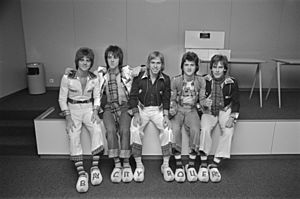
By the 1970s, artists like Rod Stewart and bands such as the Average White Band and Nazareth became internationally successful. The most successful Scottish pop group of the 1970s was the Bay City Rollers. They sold over 120 million albums worldwide! Their song "Bye, Bye, Baby (Baby Goodbye)" was the UK's best-selling single in 1975.
Another band, Pilot, had hits like "Magic" and "January". Many members of the famous rock band AC/DC, including Bon Scott and Malcolm and Angus Young, were born in Scotland before moving to Australia.
Scotland also produced many successful punk bands like The Exploited and The Rezillos. In the early 1980s, during the post-punk era, bands like Cocteau Twins, Simple Minds, and Annie Lennox (Eurythmics) became popular. The 1980s also saw the rise of indie bands like Primal Scream and The Jesus and Mary Chain.
Scottish Music Today: 1990s to Present
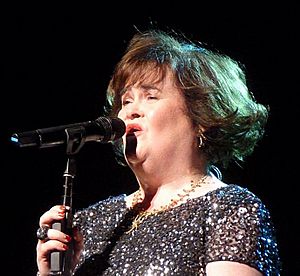
In the 1990s and 2000s, Scottish guitar bands continued to be very successful. Bands like Franz Ferdinand, Biffy Clyro, Travis, and The Fratellis gained fame. Artists like KT Tunstall, Amy Macdonald, and Paolo Nutini also became well-known. Calvin Harris became a hugely successful electronic music producer.
With the rise of music talent shows in the 2000s, Scottish artists like Susan Boyle became global stars. Susan Boyle's debut album, I Dreamed a Dream (2009), was the best-selling album worldwide in 2009. It sold over 10 million copies!
Artists like Lewis Capaldi and Nina Nesbitt have achieved international success in the 2010s and 2020s. DJ Calvin Harris holds a record for having the most top ten singles from one album in the UK. All nine singles from his album 18 Months (2012) reached the top ten.
Scotland and the Eurovision Song Contest
Scotland is part of the United Kingdom, so it does not compete separately in the annual Eurovision Song Contest. However, Edinburgh, Scotland's capital, hosted the contest in 1972. This happened because Monaco, the previous winner, could not host the event.
Glasgow, Scotland's largest city, was considered to host the 2023 contest. The UK was asked to host on behalf of Ukraine. However, Liverpool in England was chosen instead. Glasgow did host the Eurovision Dance Contest 2008.
There has been talk about Scotland joining the Junior Eurovision Song Contest, similar to how Wales participated. Scottish broadcasters like STV and BBC Alba are eligible. However, as of 2025, Scotland has not yet formally entered.
In 2018, Edinburgh hosted the Eurovision Young Musicians 2018 contest at the Usher Hall. Scotland also entered the Eurovision Choir 2019. This was the first time Scotland competed separately from the United Kingdom in a Eurovision event. The Scottish choir, Alba, performed three songs in Scottish Gaelic.
Scotland also took part in the second Free European Song Contest in 2021. Singer Amy Macdonald represented Scotland and finished in 4th place with her song "Statues".
Famous Scottish Musical Instruments
The Accordion's Lively Tunes
The accordion is a popular instrument in Scottish music, especially in country dance bands. Famous accordion players like Jimmy Shand helped make it well-known. In the early 1900s, the melodeon, a type of accordion, was popular among folk musicians. More recently, Phil Cunningham has helped keep the accordion popular in Scottish music.
The Iconic Bagpipes
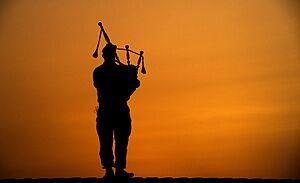
Many people think of the Great Highland Bagpipe when they think of Scottish folk music. This type of bagpipe was developed in Scotland. Bagpipes were first mentioned in Scotland in the 1400s, but they might have come to Britain with the Roman armies.
The pìob mhór, or Great Highland Bagpipe, was first played by special piping families and pipers for clan chiefs. Later, they were used in military marching bands. Famous piping clans included the MacCrimmon family.
While bagpipes are strongly linked to Scotland, similar instruments are found across Europe, North Africa, and South Asia. The Great Highland Bagpipe became widely known because of the Highland regiments in the British Army.
The classical music for the Great Highland Bagpipe is called Pìobaireachd. It starts with a main theme called the urlar. This theme is then developed through several complex movements.
Bagpipe competitions are very common in Scotland for both solo players and pipe bands. Pipers from all over the world come to compete. Other pipers explore new ways to play the instrument. Older types of bagpipes, like the border pipes and Scottish smallpipes, have also become popular again. Two highly respected pipers are Gordon Duncan and Fred Morrison.
Pipe bands are another common way to hear bagpipes. Top bands from Scotland and other countries compete in events like the World Pipe Band Championships.
Fiddle: A Key Scottish Instrument
Scottish traditional fiddling has many regional styles. These include the lively style of the Shetland Islands and the slow tunes of the northeast. The fiddle arrived in Scotland in the late 1600s.
In the 1700s, Scottish fiddling became very popular. Fiddlers like William Marshall and Niel Gow were famous. The first collections of fiddle tunes were published then. Nathaniel Gow, Niel's son, also published important collections. Classical composers like Charles McLean used Scottish fiddling traditions in their music.
Scottish fiddling is also very strong in places like Cape Breton, Nova Scotia, Canada. Many Scottish people moved there during the Highland Clearances. Musicians like Natalie MacMaster and Ashley MacIsaac have shared this music with the world.
In Scotland, Aly Bain and Alasdair Fraser are two of the most skilled fiddlers today. The Annual Scots Fiddle Festival, held every November, celebrates this rich tradition.
Guitars in Scottish Music
The guitar is a newer addition to traditional Scottish music, along with the cittern and bouzouki. It became important during the folk music revival of the 1960s. Artists like Archie Fisher and The Corries featured the guitar.
Bert Jansch was a very influential guitar player. The Incredible String Band also expanded the range of instruments used. Other notable guitarists include Tony McManus and Dick Gaughan.
Scotland has also produced many famous electric guitarists. These include Stuart Adamson of Big Country, Angus Young of AC/DC, and Brian Robertson of Thin Lizzy.
The Ancient Gittern
Instruments similar to modern guitars have been part of Scottish folk music for centuries. The Gittern, an ancestor of the guitar, appeared in medieval Scotland from at least the 1200s. It was still played in Scotland 300 years later.
The Beautiful Scottish Harp
Material evidence shows that lyres or harps, also called clarsach, have a very long history in Britain. Iron Age lyres date back over 4,300 years. The harp was considered the national instrument until the Highland bagpipes became more popular in the 1400s. Stone carvings in eastern Scotland suggest the harp was present in Pictish Scotland before the 800s. It might even be the ancestor of the modern European harp.
Only thirteen pictures of triangular harps from before the 1000s exist in Europe, and all of them are from Scotland. Pictish harps used horsehair strings. The instrument then spread to the Anglo-Saxons and the Gaels of the Highlands and Ireland. The Scottish Gaelic word for harp, Cruit, suggests it came from the Picts.
The Clàrsach (Scottish Gaelic) or Cláirseach (Irish) is the name for the wire-strung harp of Scotland or Ireland. It was the most popular instrument in Scotland until the end of the Middle Ages. Harpers were highly respected in courts of Scottish kings and chiefs. They had special rights and played important roles in ceremonies.
Three medieval Gaelic harps have survived. Two are from Scotland (the Queen Mary Harp and the Lamont Harp) and one from Ireland. However, it is thought that all three were probably made in the western Highlands of Scotland.
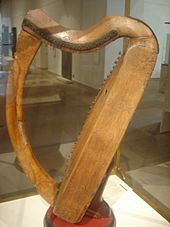
Playing the wire-strung Gaelic harp faded out in Scotland by the 1700s. In the late 1800s, there was a revival of Gaelic culture. New harps with gut strings, based on larger orchestral harps, were used. However, the name "clàrsach" is still used for these modern instruments.
Today, thousands of people play the modern gut-strung clàrsach. The Clarsach Society, formed in 1931, helped restart the modern harp tradition. Recent harp players include Savourna Stevenson. The annual Edinburgh International Harp Festival is a notable event.
The Simple Tin Whistle
One of the oldest tin whistles ever found is the Tusculum whistle. It was discovered with pottery from the 1300s and 1400s. Today, the whistle is a very common instrument in Scottish music recordings. Many pipers and flute players also play the whistle.
The Bodhrán Drum
The word bodhrán (pronounced "bow-rawn") is an Irish word for a drum. It was first mentioned in the 1600s. The bodhrán likely started in southwest Ireland in the 1700s. It was sometimes called the "poor man's tambourine." It was popular among street performers. The bodhrán became popular in Scotland and other places like Cape Breton in the 1960s, thanks to Irish music.
Celebrating Scottish Music: Awards
The Scottish Music Awards, Scottish Album of the Year Award, the Scots Trad Music Awards, and the BBC Radio Scotland Young Traditional Musician Award all celebrate musical talent in Scotland every year. These awards recognize both Scottish and international artists.
Exciting Music Festivals in Scotland
Scotland has many festivals that celebrate Scottish and international music every year. T in the Park was one of Scotland's biggest music festivals from 1994 to 2016. It attracted huge crowds every July.
TRNSMT (since 2017) replaced T in the Park. It also takes place in July at Glasgow Green and features many famous artists.
Celtic Connections started in 1994 and celebrates Celtic music. It is held every January and February in Glasgow. The Royal Edinburgh Military Tattoo features international armed forces bands. It happens every August at Edinburgh Castle as part of the Edinburgh Festivals.
Other festivals include the Eden Festival, Glasgow Summer Sessions, and the Skye Live Festival. The Glasgow Bandstand at Kelvingrove Park hosts the annual Summer Nights festival with artists like KT Tunstall and Sophie Ellis-Bextor.
Learning Music in Scotland
- Further information: Music schools in Scotland and Education in Scotland
Most schools in Scotland offer music education in secondary school. Students can earn music degrees from the Scottish Qualifications Authority (SQA). These degrees help students learn about performing, creating, and understanding music.
Scotland has several special music schools. Four of these are called "centers of excellence" by the Scottish Government. These include Douglas Academy Music School near Glasgow and the National Centre of Excellence in Traditional Music at Plockton High School.
St Mary's Music School in Edinburgh is an independent music school for students aged 8–19. Students are accepted based on their musical ability. The Scottish Government offers funding to help with tuition costs.
The Royal Conservatoire of Scotland offers scholarships for music, arts, drama, and film. It is consistently ranked among the best performing arts schools in the world. In 2022, it was ranked fifth globally for Performing Arts Education.
See also
- Gaelic music
- Music of Ireland
- Music of Wales
- Music schools in Scotland
- Royal Conservatoire of Scotland
- List of pipe bands
- Scottish Gaelic punk
- Scottish hip-hop


